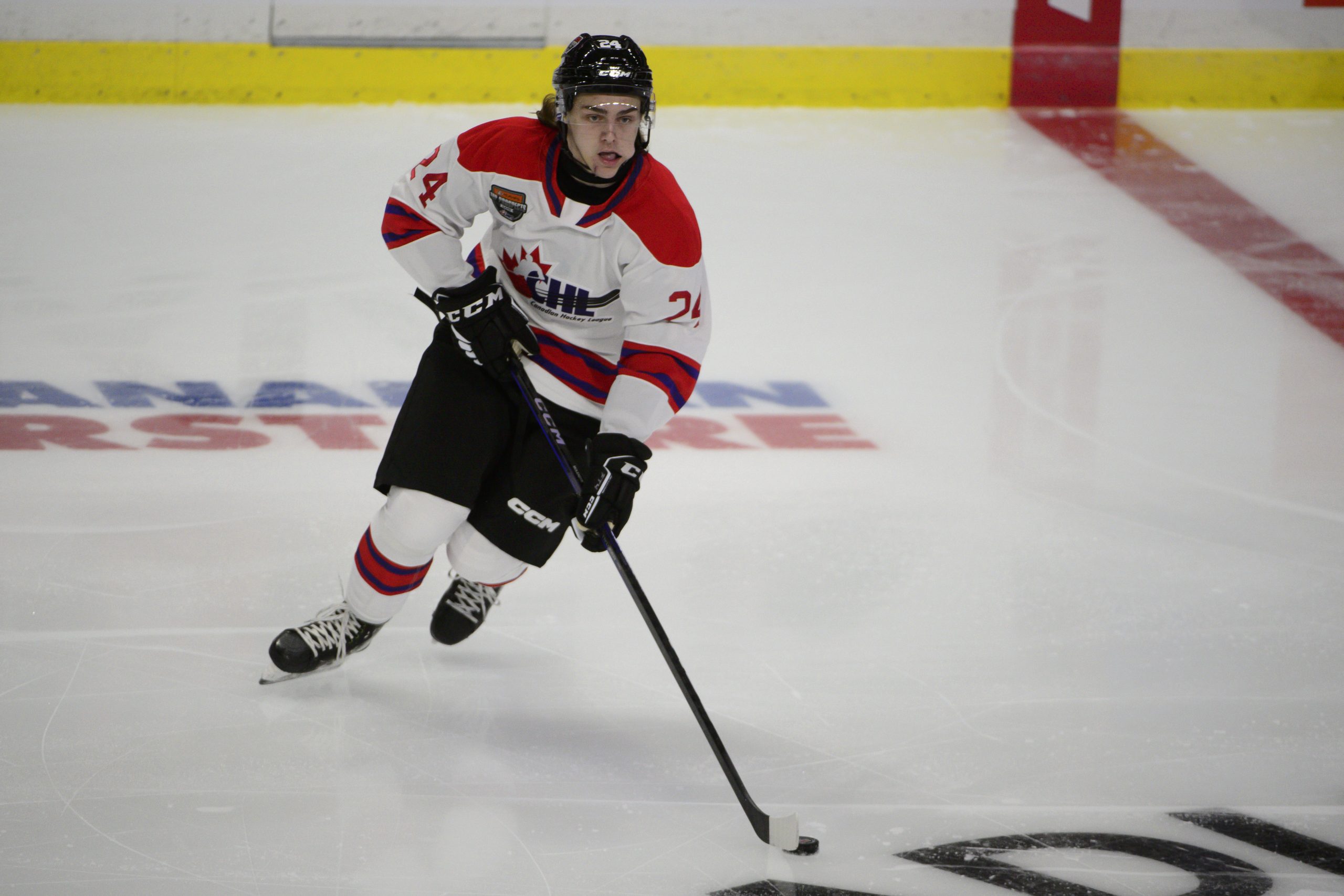Welcome back to Top Shelf Prospects, the column that brings you the next crop of professional hockey players. Each day our LWOS Prospects Writers will bring you a new player profile or topical article in the lead-up to the 2023 NHL Draft. Be sure to bookmark the site, follow Ben Kerr, Kyle Pereira and Frederik Frandson on Twitter, and spread the word for the site that will bring you analytical and critical profiles and scouting reports! Last Word On Hockey Prospects is your new headquarters for everything “NHL Draft”! Today we bring you our Tanner Molendyk Scouting Report.
 Tanner Molendyk Scouting Report
Tanner Molendyk Scouting Report
Tanner Molendyk, born on February 3rd, 2005, in Kamloops, British Columbia, is a defenceman in the WHL. The left-shot defender plays for his hometown team, the Kamloops Blazers. Standing at 5’11” and 176 pounds, Molendyk is a bit on the smaller side of the spectrum for defenders. However, that hasn’t slowed him down. He scored three goals and 15 assists for 18 points in 55 games as a 16-year-old in the WHL last season. This year, he followed that up with nine goals and 28 assists for 37 points in 67 games.
Due to the decent production from the blue line, Molendyk has been ranked anywhere from the very end of the first, all the way to the end of the second round. Those rankings include being placed 27th by FloHockey, 31st by Draft Prospects Hockey, 34th by FCHockey, 38th by McKeen’s Hockey, 39th by Elite Prospects, 40th by Smaht Scouting, 46th by Daily Faceoff, 48th by Recruit Scouting, 49th by Dobber Prospects, 58th by Craig Button, and 62nd by Bob McKenzie.
Tanner Molendyk Deep Dive
Left Defence — shoots Left
Born February 3rd, 2005 — McBride, British Columbia
Height 6’0″ — Weight 182 lbs [183 cm/83 kg]
Molendyk being ranked towards the end of the second by both Button and McKenzie likely shows teams are lower on him than the public consensus. A combination of his smaller frame and fairly underwhelming production is the likely reasons for his later rankings. But why is his production underwhelming, and can he take a big step forward with it? What else does he bring to the table?
Tanner Molendyk’s Skating
Molendyk is an excellent skater. With the larger focus on defenders who can really skate well, like the Cale Makar’s and Adam Fox’s of today, this is a big plus for Molendyk. At this time, he does not possess elite straight-line speed. But it’s not because he’s a bad skater; he just doesn’t really skate in a straight line. As a matter of fact, Smaht Scouting said it best: “Molendyk uses a lot of crossovers to build up speed when driving the puck up ice. Even though he’s heavily reliant on his crossovers, he does a good job of leveraging them to shift around pressure…”
What Smaht Scouting’s Josh Tessler is touching on is Molendyk’s habit of using crossovers while moving up ice almost constantly. That takes away from what his top speed could be if he could come off those crossovers and skate in a straight line. But that does not make him a bad skater. He’s amongst the best defenders in the class when it comes to his edges, and that’s what allows him to be such a good skater. So, while he over-uses his crossovers, they’re efficient and allow him to beat defenders up ice. It also allows him to create more with the puck on his stick, such as walking the blue line and opening passing or shooting lanes.
Offensive Abilities
In the offensive zone, Molendyk isn’t the most fast-paced guy with the puck. As a defender, that’s not a big deal. However, he can leave a bit on the table in terms of attacking the high-danger area. With the puck on his stick, he generally makes the safe play. But when he does decide to attack the high-danger area, he is largely efficient. Because of that efficiency, he should look to take a few more risks and turn up the heat a little more often. As for his shot, he doesn’t use it very often. When he does use it, there are some things to like and some things that are lacking. He’s not the most accurate, and his shot lacks consistent power.
Away from the puck, Molendyk can have moments where he acts as the fourth forward in the zone. He has no problems stepping up in the play as an option at the circles or high slot. That awareness, plus his ability to make high-end plays with his pass, makes him an intriguing projection. Molendyk has the potential to explode offensively in the WHL, but it comes down to confidence and willingness to take those risks more often. Plus, improving the consistency of his shot would add an additional element to his game.
Tanner Molendyk’s Transitional Abilities
Molendyk is heavily involved in Saskatoon’s transitional game. Regardless of the situation, whether it’s exiting the defensive zone or if a defender is looking to enter the offensive end with a pass or skating it in themselves, it’s most likely going to be Molendyk. He is creative as well. He’s not someone who takes the puck, quickly scans, and makes a straight line pass to a winger or a center a few feet in front of him. He mixes it up. Molendyk likes drawing forecheckers close, and before they apply too much pressure, he zips passes to forwards that are difficult to intercept.
However, he is inconsistent in his own end. Part of the problem is his size. When he is facing heavy pressure, and he doesn’t have the time and space to use his edges as an advantage, he’ll rim pucks up the boards. Sometimes it works and gets to a teammate, but sometimes it doesn’t. If he can bulk up, develop more lower-body and core strength, and win more of those battles consistently, he can truly open up this aspect of his game even more. It’s already very efficient, but it’ll get even more difficult to stop.
Molendyk’s Defensive Zone Play
Molendyk’s defensive game is a more aggressive style than many might expect. When it comes to defending the rush, Molendyk likes closing the gap quickly, and using his strong stick work to cancel out entries. He’s been largely efficient in this area as well for much of this season, though he has dealt with some consistency issues here. If he can’t cancel out the entry, he shows good awareness and ability to angle the puck carrier wide and away from the slot. When in-zone, Molendyk’s positioning is very good, and as mentioned, he displays strong stick work.
Where he noticeably struggles is when he’s forced into retrievals. If the opponent dumps the puck in and a forechecker is coming in fast, Molendyk does not win those races consistently. Case in point, he can’t rely on the crossovers he uses heavily when he is carrying the puck when it comes to those short-area races. He loses a lot of battles due to his lack of explosiveness and inability to get a better initial step on an opponent. Because of that, he can at times be trapped in his own end for extended periods.
Tanner Molendyk’s Potential
Molendyk has what appears to be an offensive game with potential that has to be unlocked. Hypothetically, if he unlocks that next level to his offensive game, bulks up, improves his acceleration and short-area burst, and continues to build his defensive game to be more consistent, he could be a solid top-four defender. However, consistency is hard to coach into a player, as is getting a player to play at a higher pace.
That said, Molendyk, though inconsistent, has a strong base of skills that should get him a shot at the NHL as a bottom-pair defender in the future. He still needs to improve his defensive game, especially his quickness in short puck races, to get there, but that’s easier to do than improving consistency.
NHL Comparison
Based on style only, and not a projection of skills, two players come to mind when looking at Molendyk. Those players are Ethan Bear and Miro Heiskanen. Heiskanen is a better defender, and has always been a strong option since before he was drafted. He’s far better in battles and more physically developed due to playing against men in Finland before being selected. But what is similar is the style. Heiskanen plays tight to puck carriers, defends against the rush well, and shows strong positional awareness. Heiskanen is also a strong puck-mover, but not one that’ll break a game open, same as Molendyk to this point. Finally, Heiskanen was always a good passer from the point, but hasn’t always had the best shot. He had a breakout this season, but before this year, he wasn’t a game-changer offensively.
As for Bear, he is a very smooth skater, as Molendyk is. He’s also undersized and can get overpowered in board battles. However, Bear is a very good, smart, and unpredictable transitional player. While he has a more refined offensive game, with a strong shot, that’s something Molendyk could certainly develop. Between Bear and Heiskanen, those aren’t bad names to be reminiscent of. Time will tell if Molendyk can fulfill the potential he holds moving forward, because defenders of a similar ilk as him have found success in this league already.
Highlights
Raw stats via Elite Prospects
Main Photo: Anne-Marie Sorvin-USA TODAY Sports






